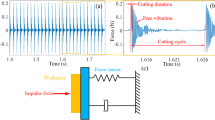Abstract
Diamond tool has significant influences on the finished surface quality in fly cutting of potassium dihydrogen phosphate (KDP) crystals. In this work, the nanoindentation and dimensional analysis are employed to establish the material constitutive equation of KDP crystals, i.e., the variation curve of flow stress vs. plastic strain. As expected, a novel 3D finite element (FE) model is developed for diamond fly cutting of KDP crystals, and the generation of 3D surface topography is simulated by multi-run cutting calculations, in which the movements of diamond tool are configured to be identical to the actual feed rate and cutting velocity. Subsequently, the coordinates of the nodes on the topmost surface as freshly machined are collected to evaluate the surface roughness, which enables the detailed analyses of the effect of diamond tool geometries on the achieved surface roughness of KDP crystals. The results suggest an optimal selection of tool geometries, i.e. −25° rake angle and 8° clearance angle. With the increment of tool nose radius, surface roughness decreases correspondingly. Moreover, the larger defect or sharpness of tool cutting edge produces the worse surface roughness. Diamond fly cutting experiments are carried out with different rake angles, in which the cutting parameters are the same as the values used in FE simulations. The measured surface roughness has a satisfied consistency with the simulated data, which demonstrates that the developed 3D FE cutting model and the related simulations are reliable.
Similar content being viewed by others
References
Taylor JS, Carlisle K, Klingmann JL, Geraghty P, Saito TT, Montesanti RC (2010) Precision engineering within the National Ignition Campaign. Proceedings of the euspen International Conference, Delft: 248–255
Montesanti RC, Thompson SL (1995) A procedure for diamond turning KDP crystals. Report in Lawrence Livermore National Laboratory (USA), UCRL-ID-121651
Fuchs BA, Hed PP, Baker PC (1986) Fine diamond turning of KDP crystals. Appl Optics 25:1733–1735
Philippe L, Christian C, Pierre D, Jacky D, Genevieve C (1999) Using a design of experiment method to improve KDP crystal machining process. Proceedings of SPIE 3492:814–820
Carroll JT, Strenkowski JS (1988) Finite element models of orthogonal cutting with application to single point diamond turning. Int J Mech Sci 30(12):899–920
Moriwaki T, Sugimura N, Luan S (1993) Combined stress, material flow and heat analysis of orthogonal micromachining of copper. Ann CIRP 42(1):75–78
Kim KW, Lee WY, Sin HC (1999) A finite element analysis for the characteristics of temperature and stress in micro-machining considering the size effect. Int J Mach Tool Manuf 39:1507–1524
Lin ZC, Lai WL, Lin HY, Liu CR (1997) Residual stresses with different tool flank wear lengths in the ultra-precision machining of Ni-P alloys. J Mater Process Technol 65:116–126
Lin ZC, Lai WL, Lin HY, Liu CR (2000) The study of ultraprecision machining and residual stress for NiP alloy with different cutting speeds and depth of cut. J Mater Process Technol 97:200–210
Lo SP (2000) An analysis of cutting under different rake angles using the finite element method. J Mater Process Technol 105:143–151
Lo S-P, Lin YY (2002) An investigation of sticking behavior on the chip–tool interface using thermo-elastic–plastic finite element method. J Mater Process Technol 121:285–292
Zong WJ, Li D, Cheng K, Sun T, Liang YC (2007) Finite element optimization of diamond tool geometry and cutting-process parameters based on surface residual stresses. Int J Adv Manuf Technol 32(7–8):666–674
Zong WJ, Sun T, Li D, Cheng K, Liang YC (2006) FEM optimization of tool geometry based on the machined near surface's residual stresses generated in diamond turning. J Mater Process Technol 180:271–278
Oliver WC, Pharr GM (1992) An improved technique for determining hardness and elastic modulus using load and displacement sensing indentation experiments. J Mater Res 7(6):1564–1583
Dao M, Chollacoop N, Van Vliet KJ, Venkatesh TA, Suresh S (2001) Computational modeling of the forward and reverse problems in instrumented sharp indentation. Acta Mater 49:3899–3918
Christopher A (1996) Tool force, chip formation and surface finish in diamond turning. Ph.D. dissertation, North Carolina State University, pp. 48–55
Zong WJ, Li ZQ, Sun T, Li D, Cheng K (2010) Analysis for the wear resistance anisotropy of diamond cutting tools in theory and experiment. J Mater Process Technol 210:859–867
Author information
Authors and Affiliations
Corresponding author
Rights and permissions
About this article
Cite this article
Zong, W.J., Li, Z.Q., Zhang, L. et al. Finite element simulation of diamond tool geometries affecting the 3D surface topography in fly cutting of KDP crystals. Int J Adv Manuf Technol 68, 1927–1936 (2013). https://doi.org/10.1007/s00170-013-4804-5
Received:
Accepted:
Published:
Issue Date:
DOI: https://doi.org/10.1007/s00170-013-4804-5



